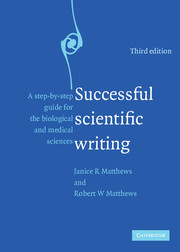Book contents
- Frontmatter
- Contents
- Preface
- Preface to the third edition
- 1 PREPARING TO WRITE
- 2 COMPOSING A FIRST DRAFT
- 3 VISUAL SUPPORT FOR THE WRITTEN WORD
- 4 VISUAL SUPPORT FOR THE SPOKEN WORD
- 5 REVISING TO INCREASE COHERENCE
- 6 IMPROVING WORD CHOICE, AND SYNTAX STYLE
- 7 ATTENDING TO GRAMMAR, NUMBERS, AND OTHER MECHANICS
- 8 THE REST OF THE STORY
- Appendix 1 Suggested responses to exercises
- Appendix 2 Excerpts from “Uniform requirements for manuscripts submitted to biomedical journals: Writing and editing for biomedical publication”
- Selected resources
- Index
1 - PREPARING TO WRITE
- Frontmatter
- Contents
- Preface
- Preface to the third edition
- 1 PREPARING TO WRITE
- 2 COMPOSING A FIRST DRAFT
- 3 VISUAL SUPPORT FOR THE WRITTEN WORD
- 4 VISUAL SUPPORT FOR THE SPOKEN WORD
- 5 REVISING TO INCREASE COHERENCE
- 6 IMPROVING WORD CHOICE, AND SYNTAX STYLE
- 7 ATTENDING TO GRAMMAR, NUMBERS, AND OTHER MECHANICS
- 8 THE REST OF THE STORY
- Appendix 1 Suggested responses to exercises
- Appendix 2 Excerpts from “Uniform requirements for manuscripts submitted to biomedical journals: Writing and editing for biomedical publication”
- Selected resources
- Index
Summary
Find a subject you care about and which you in your heart feel others should care about. It is this genuine caring, not your games with language, which will be the most compelling and seductive element in your style.
– Kurt VonnegutMost of us were drawn to science because, like Vonnegut, we found a subject we feel deeply about, not just because we wanted to write about it. However, all scientists recognize that research must be made known if it is to have lasting value. This is how science moves forward, with the shared word illuminating each step of discovery for the sake of others that follow.
“Scientific writing” can be defined narrowly as the reporting of original research in journals or more broadly to encompass other ways that scientists share research information with one another, such as review articles, posters, and slide-based presentations. (The term “science writing” is often used for writing about science topics for the general public.) Whatever form it takes, successful scientific writing must answer basic questions and address problems raised during the dialogs that identify and define a given subject. It must be clear, concise, and follow established formats. In many ways, its language forms a dialect all its own.
What is the most efficient way to write a paper or presentation that successfully covers all this? This book exists to help you tackle the task, step by step.
- Type
- Chapter
- Information
- Successful Scientific WritingA Step-by-Step Guide for the Biological and Medical Sciences, pp. 1 - 30Publisher: Cambridge University PressPrint publication year: 2007
- 1
- Cited by

